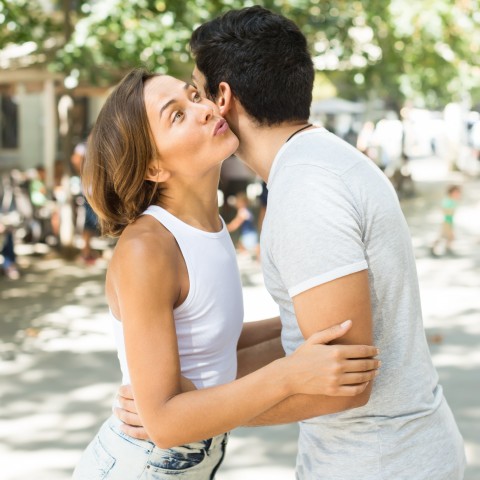
Did you know that Brazil ranks as the sixth most populous country in the world? With that many people, it’s not surprising that there are about a dozen ways of greeting someone here! And since Brazilians tend to be outgoing in their social interactions, learning how to say hello in Portuguese is a very important step for learners of the language or anyone planning to visit the country. From the grocery store to a business meeting, all interactions start with the right greeting.
Today, we will take a look at the most important Portuguese greeting phrases for all kinds of situations and times of day. After reading this article, you will have no problems greeting anyone in Brazil!
 Table of Contents
Table of Contents
- The Most Straightforward Ways: Oi and Olá
- Pick and Choose: Different Ways of Saying “How Are You?”
- It’s a Beautiful Day: Time-Dependent Greetings
- Do It Like a Brazilian: Informal Greetings
- You Again! Greeting Someone You Already Know
- What About the Hands? Handshakes, Hugs, and Kisses
- Continue Your Learning Journey with PortuguesePod101
1. The Most Straightforward Ways: Oi and Olá
There are two common Portuguese greetings you should know, both of which are very easy to remember and pronounce. Here’s how to say hello in Brazilian Portuguese using these two essential words.
The Versatile Oi
Oi (“Hi”) is a universal greeting in Brazil. But that’s not all. You might also hear oi when someone doesn’t understand what you’re saying, in the same way you would use O quê? (“What?”).
Brazilians also use oi as a way of answering when called. For example, if someone were to call you from another room in the house, you could simply reply with oi. It signals that you are listening.
Olá, the Portuguese Sibling
Another super-easy way of saying hello in Portuguese is olá. In Brazil, it is not as popular as oi, but is still commonly used. Olá feels a little bit more formal than oi, so you can opt to use it in work-related situations. Interestingly, olá is the standard greeting expression in Portugal.
2. Pick and Choose: Different Ways of Saying “How Are You?”

When you’re greeting someone in Brazil, it’s natural to ask how he or she is doing. The greeting will just feel incomplete without adding this question. Luckily, there are a bunch of ways to say it.
But first, a little explanation.
Like other Romance languages, Portuguese has two ways of saying “you.” However, in Brazil, there is no real distinction in formality between the two conjugations. Você is a bit more commonly used, but tu is still very much present in specific regions of the country. It’s mainly a matter of regionality, and not formality.
In the examples provided in this article, we’ll only be using você.
Short and Sweet: Tudo Bem and Tudo Bom
Tudo bem should definitely be part of your vocabulary! It’s a two-in-one expression, used to both ask and answer the question “How are you?” Its literal translation is “Everything [is] well.” In a conversation, it’s common to hear it like this:
Luís: Oi, tudo bem? (“Hi, how are you?”)
Ana: Tudo bem, e você? (“All good, and you?”)
Luís: Tudo bem! (“All good!”)
You might also hear Tudo bom used in the same context. While bem means “well,” bom means “good.” Both words can be used interchangeably when greeting. You can also reply with just bem or bom, or with other adjectives to explain how you are. But let’s stick with the basics for now.
As you can see, you already have enough vocabulary to greet someone in Brazil with the few words and expressions we’ve covered so far!
The Literal Versions: Como Vai and Como Você Está
The expression Como vai is a more elaborate way of asking “How are you?” Como means “how,” and vai is a conjugated form of the verb “go.”
Lastly, the expression Como você está is the literal translation of “How are you?” It’s also the ideal translation for “How have you been?” Although it can be used in both formal and informal contexts, it works particularly well in work-related situations!
Simply saying “Hello, how are you?” in Portuguese is a great start to any conversation! This combination of Oi or Olá with any of the expressions above will work in pretty much any greeting scenario.
3. It’s a Beautiful Day: Time-Dependent Greetings

What about time-specific greetings? They are very common in Brazil, especially in transactional or business situations. Greeting a business person, a lawyer, a bus driver or a shop vendor? Adding a time-specific greeting is a great way to make a good impression.
Here are a few different ways to say hello in Portuguese based on the time of day:
| Bom dia. “Good day.” / “Good morning.” | This phrase is only used until noon. |
| Boa tarde. “Good afternoon.” | This phrase is used from noon until it gets dark (around six or seven o’clock). Boa is the feminine form of “good,” and tarde is “afternoon.” |
| Boa noite. “Good night.” / “Good evening.” | This phrase is used after it gets dark. Luckily, Portuguese does not have different expressions for “good night” and “good evening.” A simple Boa noite suffices for both of them! |
Here’s an example of how a conversation might begin in a business building’s elevator:
Maria: Olá Paulo, boa tarde! (“Hello Paulo, good afternoon!”)
Paulo: Boa tarde. Como você está? (“Good afternoon. How are you?”)
Maria: Estou bem, e você? (“I’m well, and you?”)
Paulo: Tudo bom! (“All good!”)
4. Do It Like a Brazilian: Informal Greetings
Let’s say you’re meeting a group of your closest friends, and you want to greet them as Brazilians do. There are two main greetings you should learn for informal settings.
E aí: The Jack-of-All-Trades
E aí is quite a versatile expression! While it serves as a casual hello in Portuguese, it can also be used to mean “What’s up?” or “Yo!” For example, a friend of yours might see you while you’re walking down the street and get your attention by shouting E aí!
Explaining the meaning of E aí is a bit funny, because it’s an incomplete expression: E is “and,” while aí means “there” or “then.” Remember when I said it was a versatile expression? You can also use it when someone is telling a really juicy story, and you want to know what happens next. In this case, E aí? Would be closer in meaning to “And then?”
Beleza: What a Beauty
Now that you’ve nailed E aí, it’s time to learn another informal hello in Portuguese: Beleza. Beleza means “beauty,” and we use it to both ask and answer “How is it going?” When meeting your friends, you can even combine both expressions, like this:
Ana: E aí! (“Yo!”)
Luís: E aí, beleza? (“Yo, what’s up?”)
Ana: Beleza! E você? (“All good! And you?”)
Luís: Tudo bem! (“All good!”)
If you use these expressions in an informal situation, you’ll be getting some impressed smiles from your friends!
5. You Again! Greeting Someone You Already Know

What about when you meet someone you haven’t seen for a while? Tudo bem and Como vai are good ways to start, but it doesn’t feel like enough in scenarios like that. In Brazil, there are some other phrases you would probably use.
Quanto tempo is a great way to say “Long time no see.” Another handy expression is Que bom te ver, which means “Good to see you.” You can even add de novo (“again”) at the end of the sentence, as in this example:
Paulo: Oi, quanto tempo! (“Hi, long time no see.”)
Maria: Que bom te ver de novo! Como vai? (“Good to see you again! How are you?”)
Paulo: Bem! E você? (“Well! And you?”)
Maria: Tudo bem também. (“All well, too.”)
6. What About the Hands? Handshakes, Hugs, and Kisses
Greeting someone in Brazil goes beyond the words we use. Brazilians don’t have any problem with touching other people, and it’s very common to do so when saying hello.
Since the country is so huge, there are regional differences when it comes to greeting gestures. Therefore, this will only be a broad overview; keep in mind that it might differ depending on where you go.
In both formal and informal situations, including business environments, two things commonly happen when arriving at and leaving a place:
- Men shake hands
- Women kiss other women and men
How many times do you kiss on the cheek? That’s a tricky question because it varies a lot! For example, two kisses is the norm in Rio de Janeiro. But in São Paulo, it’s just one. So make sure to ask a local as soon as possible.

Of course, there might be exceptions to the rule-of-thumb above. Some people might be really uncomfortable with physical touch: if a woman shoots up a hand for you to shake, go with the flow and just shake hands. In informal situations or with close friends and relatives, people might just go in for a hug, regardless of gender.
Greeting gestures are a bit more nuanced than the actual expressions explained in this article. But don’t worry too much about it. Brazilians are warm people, open to explaining our culture and our ways!
7. Continue Your Learning Journey with PortuguesePod101
In the end, Portuguese allows you to mix and match your favorite greetings! Now that you know how to greet in Brazilian Portuguese, have fun and try saying hello in different ways. And remember, a smile always goes a long way!
Since you’re now an expert in greetings, it’s time to explore PortuguesePod101.com and find all the tools you need to learn more about this beautiful language! You can start by heading over to our article on How to Introduce Yourself or look for other fun Portuguese expressions to practice.
Did you learn anything new in this article? Are there any greeting phrases you still want to learn? Let us know in the comments!
Remember to practice the different Portuguese greetings and responses in the meantime. Good luck and see you soon!









